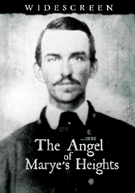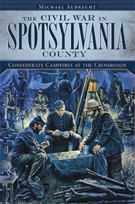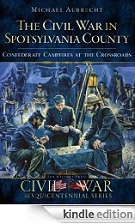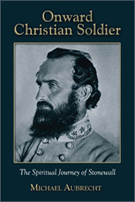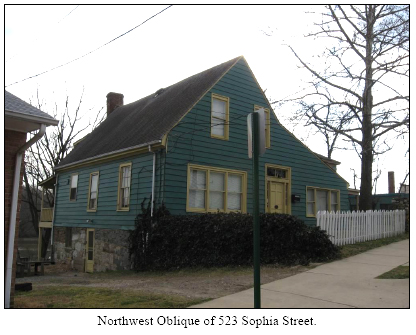
One of the biggest benefits of living in a tourist town like Fredericksburg Virginia is the fact that the entire city and surrounding countryside is covered in historical sites. Something as simple as going to work everyday finds me passing Civil War battlefields, colonial fort signs, and street upon street of landmark buildings. Every weekday morning at the crack (of-the-crack) of dawn, you will most likely find me walking down Sophia Street on my way to catch the VRE commuter rail at the Fredericksburg Train Station. One home in particular always catches my weary, bloodshot eyes as I pass by. It is the circa 1700’s house at 523 Sophia Street, certainly one of the more unusual looking residences and perhaps the oldest.
After voicing my interest in this house to my friends at the National Park Service I was directed to a local cultural resource consulting firm called Dovetail Cultural Resource Group. DCRG is a full-service, woman owned (SWAM certified) Cultural Resource management (CRM) firm. Dovetail's principals, Kerri Barile and Mike Carmody, have 25 collective years of experience conducting federal, state, and local preservation compliance work. They were hired by the property owner to conduct an intense study of the home and its history. Kerri Barile was generous enough to provide me with a copy of their findings and photographs and I am very grateful for her support.
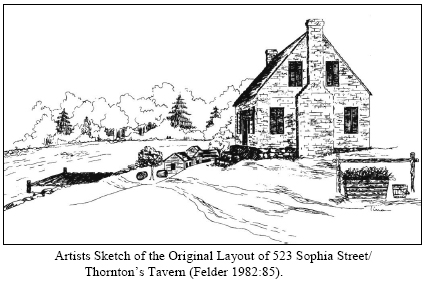
According to Dovetail’s report: “The history of…523 Sophia Street begins with the founding of Fredericksburg. The future townsite of Fredericksburg was granted to John Buckner and Thomas Royston in 1671. Though they never lived on this 2,000 acre property, they immediately leased the land to William and Sukey Livingston, which is how the area became known as ―The Leaseland from the 1670s through the 1720s. The community remained a small river enclave through the first two decades of the eighteenth century.” They added, “What is today the…523 Sophia Street property was just outside of the original town boundaries.”
In order to put the significant historical value of this home in perspective, we must first present how Fredericksburg fit into the colonial-era. The original English settlement of Fredericksburg Virginia was chartered in 1728. Named for Frederick, Prince of Wales, the town’s footprint was clustered in a fifty-acre area along the west bank of the Rappahannock River. It was originally engineered in a grid-like pattern, with wide streets that were named after British royalty. The initial plot consisted of sixty-four equally sized lots with two extra spaces for a church and a market. As the population increased, Fredericksburg found it necessary to expand the municipal boundaries. By 1759, the city had tripled its physical size, opening the door to both new merchants and settlers alike.
Many significant names from both the Colonial and Revolutionary periods called Fredericksburg home to include George Washington, Fielding Lewis, Hugh Mercer, George Weedon, John Paul Jones and James Monroe. Thomas Jefferson, although not a resident, frequented the area on a number of occasions and penned the Virginia Statute for Religious Freedom there.
Although the tract on which Fredericksburg was founded had included a frontier fort that had been established in 1676, its firsthand witnessing of military action in the fight for independence was none. It was the other Fredericksburg, of New York, that witnessed one of the first armed incidents leading up to the American Revolution. In November of 1765, two regiments of British troops arrived from Poughkeepsie and merged with another 200 Redcoats from New York City who were deployed to stop the spread of British land encroachment by local Patriots. Fredericksburg, Virginia that is, did make a significant contribution in the fight for liberty after Charles Dick teamed up with Fielding Lewis in 1775 to run the Fredericksburg gunnery. They would supply muskets for Colonial troops throughout the Revolution, while also repairing muskets captured from the British.
The story of 523 Sophia Street began long before America’s fight for independence. As Fredericksburg had worked early on to establish itself as an important port along the Rappahannock River, the city constructed a series of wharfs which became the first public river docks. Numerous warehouses developed around the waterfront to accommodate the new influx of business. The majority of these structures were located along Sophia Street.
According to Dovetail, William Byrd II visited Fredericksburg shortly after the county seat moved from Germanna. He discussed this experience in his diary where he wrote, “Colonel Willis walked me about his town of Fredericksburg. It is pleasantly situated on the south shore of Rappahannock River, about a mile below the falls. Sloops may come up and lie close to the wharf, within thirty yards of the public warehouses, which are built in the figure of a cross…Though this be a commodious and beautiful situation for a town, with the advantages of a navigable river and wholesome air, yet the inhabitants are very few. Besides Colonel Willis, who is the top man of the place, there are only one merchant, a tailor, a smith, and an ordinary keep.”
Modern dendrochronology (the science dealing with the study of the annual rings of trees in determining the dates and chronological order of past events) has showed that the home at 523 was built in 1746, making it the oldest confirmed building in Fredericksburg. It was originally a tavern and then a store before becoming a private residence. From the mid-1740s until his death in 1753, William Hunter and his nephew James ran a mercantile shop out of the old tavern building. When William passed away, he willed his property to his son James stating: “I bequeath to my son James Hunter my ferry lots with the benefit of the ferry and all houses belonging to them.” His widow, Martha Hunter, left the area with her children shortly after the death of her husband. Occupation of the parcel was then taken up by Williams‘s nephew and business partner James. Unfortunately, the partnership that had been was lost, and James soon found himself requesting payment of all the debts that were owned to him and his uncle.
Dovetail’s report outlines the decline that followed: “What was Thornton‘s Tavern had ceased to be a public venue after the property passed to James Hunter in the 1750s. Hunter discontinued the mercantile shop established by him and his uncle William, but it is likely that he continued to use the property as his residence. James also continued to own and operate the ferry. In 1771, James Hunter Junior returned to Fredericksburg to take over the land that his father left him almost 20 years earlier. However, two years later, he attempted to rent the ferry and shop as he planned to move to Britain. With the increasing hostilities between American and Britain, James apparently never went to Britain, as he advertised in the Virginia Gazette (1776) shortly after for a lost horse. Instead, James Junior attempted to revive the mercantile trade from this lot, but his new enterprise only lasted less than ten years.”
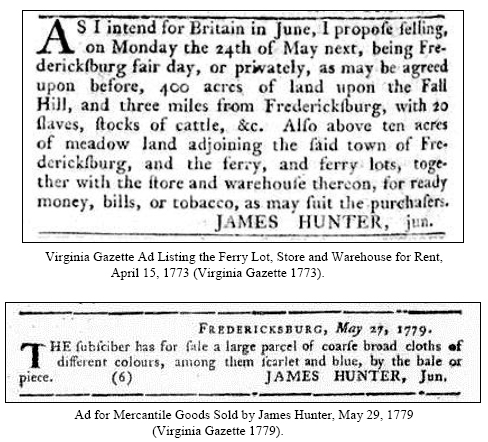
Upon the death of James Hunter Junior, the property passed to Archibald Hunter who never occupied the lot, or even lived in town. In 1814, the property was sold out of the Hunter family for the first time in almost 75 years. Joshua Long purchased the parcel which was bounded by the town wharf lot on the upper side, by the River Rappahannock on the East, by John T. Walker‘s Lott on the lower Side, and by Sophia Street on the back. The property remained in use as a residence and went on to witness (and survive) the Federal occupation and destruction that plagued the town during the Civil War. Today the home remains in remarkable shape, albeit an unusual color. It is currently used as part of an alcohol rehabilitation program and is slated for architectural restoration.
Perhaps Dovetails’s findings and recommendations best summarize how this lone, unassuming home remains an important link to the city’s past: “The building at 523 Sophia Street is an excellent example of an eighteenth century building that has been modified to fit owner needs and reoriented to comply with the new flow of a growing town. With an initial construction date of 1737, it is the oldest building in Fredericksburg. Even with a new timber frame structural system, a second half of the eighteenth century modification date still ranks among the oldest buildings in town. From a tavern to a mercantile shop and from a residence to a junk yard, the building at 523 represents the spectrum of Sophia Street and the larger changes affecting life in Fredericksburg for over three decades. Based on the architectural analysis and its historic context, it is recommended that 523 Sophia Street/Thornton‘s Tavern is both individually eligible for the National Register of Historic Places (NRHP) and is a contributing element to the Fredericksburg Historic District under Criteria A and C. The building exemplifies the city‘s growth from its earliest days through the twentieth century. Architecturally, the building is an excellent example of a modified vernacular Southern Colonial. Elements that highlight this style include the use of Berea/Aquia sandstone in the foundation and original chimney stacks, a timber frame structural system using hewn beams and pegs, and a sharply-pitched gable roof.”
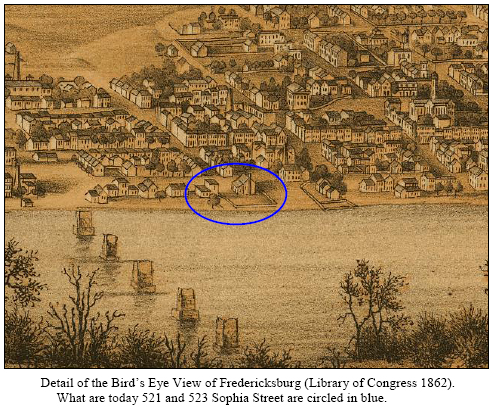
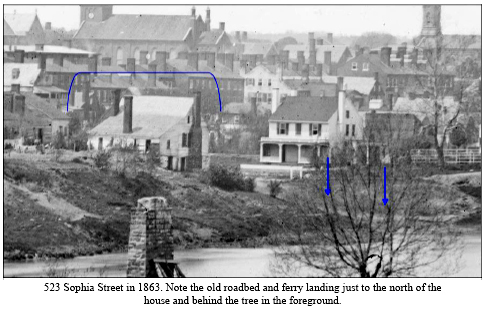
Updated: Saturday, 22 October 2011 5:49 PM EDT
Permalink | Share This Post
